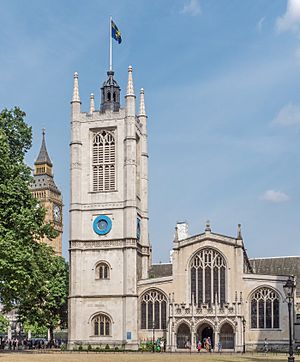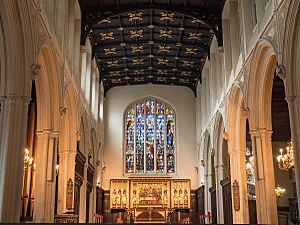St Margaret's, Westminster facts for kids
Quick facts for kids St Margaret's, Westminster Abbey |
|
|---|---|

St Margaret's Church, Westminster Abbey, with the Elizabeth Tower ('Big Ben') of the Palace of Westminster in the background
|
|
| Location | City of Westminster, London, UK |
| Founded | 12th Century |
| Rebuilt | 1486 to 1523 |
| Official name: Palace of Westminster, Westminster Abbey and Saint Margaret's Church | |
| Type | Cultural |
| Criteria | i, ii, iv |
| Designated | 1987 (11th session) |
| Reference no. | 426 |
| Country | United Kingdom |
| Region | Europe and North America |
| Lua error in Module:Location_map at line 420: attempt to index field 'wikibase' (a nil value). | |
The Church of St Margaret, Westminster Abbey is a famous church in London, England. It stands right next to Westminster Abbey and the Palace of Westminster. This church is dedicated to Saint Margaret of Antioch. Together, these three important buildings form a single World Heritage Site. This means they are recognized globally for their special history and culture.
Contents
Discover the History of St Margaret's Church
The church was first built in the 1100s by Benedictine monks. They wanted a separate church for local people to worship in. This way, the community had its own simpler church, different from the grand Abbey.
How the Church Changed Over Time
St Margaret's was rebuilt between 1486 and 1523. King Henry VII asked for this new building. The church you see today is mostly the one finished in 1523. It was one of the last churches in London built in the old Catholic style before the Reformation.
In the 1540s, the church almost got torn down! A powerful man named Edward Seymour wanted its stones for his own new palace. But the local people bravely stood up and stopped him.
St Margaret's and Parliament
In 1614, St Margaret's became the official church for the Palace of Westminster. During the 1600s, a group called the Puritans preferred this church. They found it more suitable for their Parliament services than the grand Abbey. This tradition continues even today.
The church's look changed again between 1734 and 1738. The north-west tower was rebuilt, and the whole building was covered in Portland stone. Later, new entrances were added. In 1878, the inside of the church was updated by Sir George Gilbert Scott. Many original Tudor features were kept, though.
By the 1970s, fewer people lived nearby. So, the church became part of Westminster Abbey's authority. Today, the Rector (main priest) of St Margaret's is often also a canon of Westminster Abbey.
Special Stained-Glass Windows
One of the most famous features is the east window, made in 1509. This beautiful Flemish stained glass window celebrates the engagement of Catherine of Aragon to King Henry VIII. This window has traveled a lot! It was moved many times before finally coming to St Margaret's in 1758.
Other windows remember important people. These include William Caxton, England's first printer, and Sir Walter Raleigh. The poet John Milton and Admiral Robert Blake are also honored here.
Weddings at St Margaret's
St Margaret's Church is a very popular place for weddings. Members of Parliament, important lords, and staff from the House of Lords and House of Commons can choose to get married here.
Famous Weddings Held Here
Many well-known people have tied the knot at St Margaret's:
- 5 July 1631: Edmund Waller and Anne Banks
- 1 December 1655: Samuel Pepys and Elisabeth Marchant de St. Michel
- 12 November 1656: John Milton and Katherine Woodcock
- 12 September 1908: Winston Churchill and Clementine Hozier
- 21 April 1920: Harold Macmillan and Lady Dorothy Cavendish
- 18 July 1922: Lord Louis Mountbatten and Edwina Ashley
- 8 October 1993: David Armstrong-Jones, Viscount Linley and the Hon. Serena Stanhope
Baptisms at St Margaret's
Many notable people have been christened (baptized) at St Margaret's Church over the centuries.
- Charles Weston, 3rd Earl of Portland, 19 May 1639
- Barbara Villiers, 27 November 1640. She later had children with King Charles II.
- Charles Montagu, 1st Earl of Halifax, 12 May 1661
- Charles FitzRoy, 2nd Duke of Cleveland, 16 June 1662. He was the son of Barbara Villiers and King Charles II.
- Olaudah Equiano, a former slave who became a key leader in the movement to end slavery, was christened here on 9 February 1759. He was described in the church records as "Gustavus Vassa a Black born in Carolina 12 years old".
Burials at St Margaret's
Many important figures from history are buried at St Margaret's Church or its churchyard.
- William Caxton, 1491, England's first printer.
- John Sutton, 3rd Baron Dudley, 18 September 1553.
- John Sheppard, December 1558, a famous composer.
- Blanche Parry, 1590, a close friend and servant of Queen Elizabeth I.
- Thomas Churchyard, 1604, an Elizabethan poet and soldier.
- Sir Walter Raleigh, 1618, a famous explorer and writer.
- After the King returned to power in 1661, some Parliamentarians who had been buried in Westminster Abbey were moved. They were reburied in an unmarked grave in St Margaret's churchyard. A special memorial for them is on the church's outside wall.
- Wenceslas Hollar, March 1677, a famous artist.
- Ignatius Sancho, 1780, a composer, writer, and important voice against slavery.
Other Important Moments
In 1555, during the reign of Queen Mary I, a former monk named William Flower was burned at the stake outside the church. This happened because he disagreed with the church's teachings on the sacrament.
During the First World War, a headmaster named Edward Lyttelton gave a sermon here. He spoke about "loving your enemies" and wanting a fair peace treaty with Germany. Some people disagreed strongly and protested outside the church.
Music at St Margaret's
St Margaret's has a strong musical tradition. The young singers (treble choristers) for the church come from Westminster Under School. The church also hosted the first performance by the UK Parliament Choir in 2000.
The Church Organ
The church has a large and impressive organ. The first organ was installed in 1806. The current organ was mostly built by J. W. Walker & Sons Ltd. Many talented organists have played here over the years.
Images for kids
-
St Margaret's Church. To the left is the Elizabeth Tower of the Palace of Westminster; to the right is the Abbey.
-
St Margaret's, seen from the London Eye Ferris wheel
See also
 In Spanish: Iglesia de Santa Margarita (Westminster) para niños
In Spanish: Iglesia de Santa Margarita (Westminster) para niños







